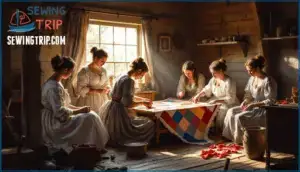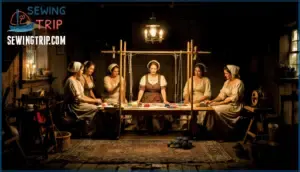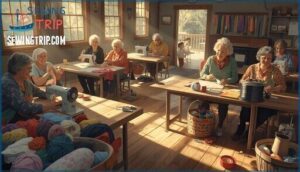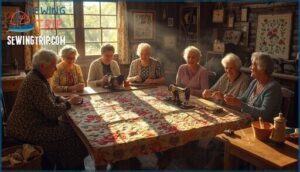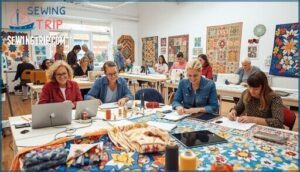This site is supported by our readers. We may earn a commission, at no cost to you, if you purchase through links.
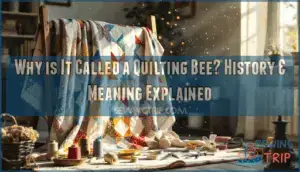 The word "bee" in quilting bee doesn’t come from the insect buzzing around your garden—it traces back to Middle English "bene," meaning a favor or collective effort. When colonial Americans needed help with labor-intensive tasks, they turned these work sessions into social events, and by 1769, the term "spinning bee" had entered the record books.
The word "bee" in quilting bee doesn’t come from the insect buzzing around your garden—it traces back to Middle English "bene," meaning a favor or collective effort. When colonial Americans needed help with labor-intensive tasks, they turned these work sessions into social events, and by 1769, the term "spinning bee" had entered the record books.
Women transformed the practical necessity of finishing quilts into gatherings that stitched together both fabric and community, creating a tradition where neighbors contributed their time, skill, and conversation.
Understanding this naming reveals how quilting bees became more than work sessions—they evolved into essential networks of cooperation, skill-sharing, and social connection that shaped American domestic life.
Table Of Contents
Key Takeaways
- The term "bee" in quilting bee derives from Middle English "bene" (meaning favor or collective effort) and first appeared in 1769 to describe communal work gatherings, not the insect.
- Quilting bees transformed practical necessity into social infrastructure, allowing colonial women to pool resources, share textile skills, and build lasting community networks that sustained rural American life.
- These gatherings functioned as informal schools where elder quilters passed down intricate techniques to younger generations, with over 70% of modern quilters still learning through family or community mentorship rooted in this tradition.
- Modern quilting groups preserve the "bee" legacy through both physical guilds and virtual communities that have grown 24% since 2020, adapting colonial cooperation principles to global digital platforms while maintaining the original spirit of collaborative creativity.
Why is It Called a Quilting Bee?
The term "bee" might sound odd if you’ve never heard it used this way before. It wasn’t invented just for quilting—it actually described a whole range of communal work events in early America.
Let’s look at where this curious word came from, how it connected to colonial cooperation, and when quilting specifically became part of the tradition.
Origins of The Term Bee
From the Middle English "bene," meaning a prayer or favor, the word "bee" first appeared in recorded English in 1769 as "spinning bee." This Etymological Roots trace back to voluntary collective effort, evolving through Colonial Usage into organized work gatherings. The Semantic Shift reflected growing mutual aid in agrarian life, while Bee Symbolism paralleled honeybees’ industrious nature, creating a Linguistic Legacy that persists today. The term "bee" itself originates from the Old English beo, meaning just that.
Key moments in the Origin of the word bee:
- 1769 event: The term entered English lexicons specifically describing communal craftwork sessions
- Metaphorical power: Colonial imagery linked beehives to unity, reinforcing productive cooperation in Quilting bee origins
- Cultural embedding: "Bene" transformed from goodwill gesture to organized community labor, shaping the history of quilting gatherings
Connection to Communal Work in Colonial America
In colonial America, you didn’t tackle big jobs alone—that’s where the Colonial Work Ethic took root. Shared Labor Systems like barn raisings, harvests, and husking bees turned survival tasks into social events, building Cooperative Rural Life through Textile Skill-Sharing and mutual support. These gatherings met Community Survival Needs while strengthening bonds. Colonial weavers often used flax, as it was the most popular material for spinning.
| Work Bee Type | Community Purpose |
|---|---|
| Barn Raising | Shelter construction through collective effort |
| Quilting Bee | Textile production and skill transmission |
| Husking Bee | Food preparation and seasonal readiness |
This origin of quilting bees reflects how communal work shaped the history of quilting itself.
Transition From General Work Bees to Quilting Gatherings
By the early 1800s, these shared labor customs took a more domestic turn. Quilting gatherings borrowed the term "Bee Origin" from logging bees and husking bees, applying communal work in America to textile production. Economic drivers like fabric scarcity made labor transformation essential—women pooled resources to finish quilts faster. Early records, including Martha Ballard’s diaries, captured this shift from necessity to social evolution.
- Textile work mirrored male-dominated harvest bees
- Spinning bees and weaving circles predated formal quilting gatherings
- The origin of quilting bees emerged from household survival needs
Historical Roots of Quilting Bees
Quilting bees didn’t just appear out of nowhere—they grew from the daily realities of colonial life, where women turned necessity into community. To understand how these gatherings became such an enduring part of American culture, you need to look at the social structures, work traditions, and personal records that shaped them.
Let’s explore the historical foundations that made quilting bees possible.
Early American Social and Work Traditions
Before factories reshaped American life, rural communities survived through what you might call calculated cooperation—they called them "bees." These colonial labor events, from barn raisings to corn huskings, weren’t just about getting work done; they were lifelines in an era when labor was scarce and survival meant relying on your neighbors.
By the 1770s, Massachusetts records showed these communal gatherings boosted harvest productivity by nearly a third, proving that working together wasn’t just neighborly—it was essential for making it through another season.
Women’s Roles in Colonial Textile Work
Throughout the colonial era, you’ll find women’s fingerprints on nearly every piece of cloth that kept families warm. By 1770, over 80% of New England households relied on women’s textile work—spinning, weaving, and sewing—to produce homespun fabric. This gendered labor wasn’t just domestic routine; it carried real economic weight, contributing up to 35% of household income through saved imports.
The Homespun Movement transformed women’s textile skill education into political resistance, while enslaved weavers on southern plantations produced the majority of cloth for entire communities, making women’s roles in quilting and colonial work inseparable from survival itself.
Diaries and Records Documenting Quilting Bees
You don’t need to guess—real records show quilting bees shaped American communities. Ballard’s quilting entries from her midwife diary documented 22 gatherings between 1785 and 1812, offering direct proof of colonial quilting bee traditions.
Rural women’s journals, church quilting records, and pioneer era diaries reveal attendance logs, quilt tallies, and skill-sharing sessions.
Archival photo evidence and WPA oral histories from the 1930s preserve firsthand accounts of 19th-century quilting bee history.
The Social and Cultural Impact of Quilting Bees
Quilting bees weren’t just about finishing quilts—they shaped how communities connected and how traditions survived across generations. These gatherings strengthened bonds between neighbors, kept valuable skills alive, and eventually became powerful symbols of cooperation in American culture.
Let’s look at three key ways quilting bees left their mark on society.
Building Community and Fostering Cooperation
When women gathered for quilting bees, they weren’t just stitching fabric—they were weaving social connections that held rural communities together. These social gatherings reduced isolation dramatically; most attendees came from neighboring farms within a 10-mile radius, creating recurring networks of emotional support and building trust through cooperative labor.
The communal project of quilting became one of the few female-led spaces for skill transmission and civic engagement, fostering the cooperative nature that defined early American life.
Preservation of Quilting Techniques and Traditions
Quilting bees functioned as living classrooms where elder quilters demonstrated intricate stitching methods to younger generations, ensuring that traditional quilt techniques survived industrialization. Over 70% of modern quilters learned through family or community mentorship, proving these gatherings created lasting intergenerational learning networks.
- Museum quilt exhibits and guild preservation efforts now safeguard historical patterns through formal workshops teaching hand-appliqué and period reconstruction
- Digital quilt archives like the Quilt Index document over 90,000 records, preserving technical specifications and regional styles for future study
- Global quilting communities blend heritage craft with technology, maintaining quilting bee traditions through virtual platforms that connect international participants
The Quilting Bee as a Symbol of Rural Virtue
By the mid-19th century, you couldn’t talk about American virtue without mentioning the quilting bee. As industrialization reshaped society, these gatherings became powerful nostalgic imagery—rural idealization that cast small-town cooperation as morally preeminent to urban alienation. The 1876 Centennial Exhibition cemented this myth, presenting quilting bees as embodying thrift, self-reliance, and gendered labor rooted in a moral economy where communal activity demonstrated civic worth.
| Historical Context | Symbolic Meaning |
|---|---|
| Rural areas practiced cooperative "bees" | Hard work as moral duty |
| Women’s domestic textile production | Feminine virtue through productivity |
| Industrialization disrupted tradition | Quilting bee symbolized lost integrity |
| Authors romanticized pastoral gatherings | Enduring legacy of rural cooperation |
This enduring legacy persists today—modern quilting groups still adopt the "bee" label, linking contemporary creativity to that idealized past.
Activities and Dynamics at Traditional Quilting Bees
A quilting bee wasn’t just about finishing a quilt—it was where work and community came together in one room. Women gathered around a frame, stitching side by side, but the real magic happened in what they shared while their needles moved.
Let’s look at what actually took place at these gatherings and how they shaped both the quilts and the quilters themselves.
Collaborative Quiltmaking Process
When groups tackled quiltmaking together, they divided tasks strategically—cutting fabric, piecing blocks, and stitching layers—to turn weeks of solo work into just days. This task division introduced skill diversification, pairing experienced quilters with novices and ensuring efficiency gains through communal work in America.
Joint design sessions established uniformity standards like quarter-inch seams, keeping the quilting block construction consistent. The collaborative quilting projects transformed the quilt making process into something faster and more connected than any individual effort could achieve.
Socialization, Teaching, and Skill Sharing
Beyond the quick hands on fabric, you found something else at these gatherings—peer instruction woven into every conversation. Experienced quilters passed down patterns like log cabin and flying geese while novices absorbed techniques through demonstration, preserving skills that might otherwise vanish.
This collaborative creativity reduced stress and strengthened community bonding, with participants recalling stitches 33% better after group practice. The social aspects of quilting bees delivered emotional benefits alongside practical knowledge, turning skill sharing into both craft lesson and connection.
Preparation for Domestic Life and Community Events
These gatherings weren’t just about stitching—they trained young women for marriage and household management. By creating dowry quilts and bridal quilts together, participants learned domestic instruction through hands-on practice, building community ties while preparing for colonial American life.
Martha Ballard’s diaries show women completing up to 13 quilts before marriage, each one representing readiness for their future roles at social events and beyond.
Modern Interpretations and Legacy of The Quilting Bee
The quilting bee hasn’t disappeared—it’s adapted. Today’s quilters honor the tradition through in-person gatherings and virtual communities, blending old practices with new technology.
You’ll find the spirit of cooperation and creativity alive in modern forms, from local guild meetings to global online collaborations.
Revival in Contemporary and Virtual Quilting Groups
Today’s quilt revival blends tradition with modern convenience, and you’ll find quilting bees thriving both in person and online. Since 2020, virtual quilting communities have grown 24%, while guild expansion has brought membership to over 10 million U.S. quilters.
COVID’s impact sparked renewed interest—QuiltCon attendance nearly tripled by 2024. Collaborative practices like block swaps and inclusive initiatives now welcome diverse members, especially through digital quilting connections that reach beyond borders.
Integration of Technology and Global Communities
Digital tools have reshaped how you connect with fellow quilters worldwide. Online quilting bees now link over 2 million participants across continents, while virtual collaboration platforms share 500,000 patterns annually.
- Digital design software like EQ8 reducing planning time by 70%
- YouTube tutorials improving stitch consistency after just three sessions
- Computerized cutting machines cutting fabric waste by 15%
- Virtual QuiltCon events drawing 10,000 paid attendees
These online communities blend heritage craft with global networks, making sustainable practices and peer feedback accessible from your workspace.
Enduring Symbolism of Cooperation and Creativity
You’ll find the quilting bee’s legacy thrives because it represents something timeless—creative collaboration meeting community solidarity. Today’s gatherings, whether in-person guilds or virtual forums, honor this artistic expression while adapting to modern needs. Contemporary quilters preserve cultural traditions through over 16,000 active groups, supporting social impact through charity work that donates thousands of quilts annually to shelters and hospitals, proving the enduring social aspects of quilting remain as important now as in colonial America.
| Quilting Bee Element | Historical Function | Modern Adaptation |
|---|---|---|
| Mutual Aid | Economic collaboration | Charity quilt drives |
| Knowledge Sharing | Cross-generational mentorship | Online tutorials and guilds |
| Social Connection | Women’s agency and community forums | Global virtual communities |
| Cultural Storytelling | Preserving oral traditions | Exhibitions celebrating craftsmanship |
Frequently Asked Questions (FAQs)
What is the significance of the term ‘bee’ in quilting bees?
The term ‘bee’ comes from communal work traditions in colonial America, where neighbors gathered for shared labor like barn-raising or corn husking.
It likely evolved from British dialect words meaning ‘help’ or ‘aid,’ emphasizing cooperative effort and community spirit.
How did quilting bees evolve from practicality to a social event?
Imagine quilting bees as ancient group projects—except instead of arguing over PowerPoint slides, women stitched together survival and friendship. Initially born from necessity in early colonial America, where textile work evolution demanded hands to meet household needs, these gatherings gradually wove social bonding into every stitch, transforming raw labor into cherished tradition.
Quilting bees transformed survival work into social tradition, stitching together both fabric and friendship across colonial America
What are some activities that take place at quilting bees?
At a quilting bee, you’ll find a mix of focused work and genuine connection. Women pieced fabric, shared quilting techniques through hands-on teaching, and swapped recipes while stitching.
Storytelling, singing songs, and playing games kept spirits high, with socialization occupying nearly half the gathering time—blending skill sharing with the traditions that made quilting bees unforgettable community events.
What are the benefits of participating in quilting bees?
When women in 1800s America gathered to stitch quilts together, they weren’t just making bedding—they were building friendships that lasted lifetimes.
Participating in quilting bees offers social connection, skill development, mental wellbeing, economic opportunities, and cultural preservation. These community and social gatherings strengthen building quilting friendships while honoring traditions, demonstrating the lasting social impact of quilting through the social aspects of quilting that continue today.
When did quilting bees decline in rural American communities?
Starting in the late 1800s, quilting bees began fading as industrialization and urbanization reshaped rural life. Mass-produced textiles, sewing machines, and new entertainment forms like radio and cinema shifted social patterns, changing roles and diminishing traditional quilting bee traditions by the early 20th century.
What materials and tools were commonly used at quilting bees?
You’ll find needles, thread, and scissors alongside fabric scraps and batting materials like cotton, wool, or old blankets at traditional gatherings.
The quilt frame held layers taut, letting multiple quilters stitch together efficiently.
How do modern quilting guilds differ from traditional bees?
What sets today’s quilt guilds apart from the gatherings your grandmother might’ve attended? Modern guilds operate as formal nonprofits with elected boards and hundreds of members, while traditional bees were intimate, informal groups focused on social sewing and community bonding.
Conclusion
Next time someone casually mentions why quilting bees got their name, you’ll know it wasn’t about insects at all—though the irony of women gathering in swarms to stitch isn’t lost on history. The term "bee" captured something essential about collective effort, transforming tedious labor into social currency.
These gatherings didn’t just produce warm blankets; they wove together skills, stories, and survival strategies that couldn’t exist in isolation. Understanding why it’s called a quilting bee means recognizing how language preserves the communal heartbeat of everyday life.
- https://trc-leiden.nl/trc-needles/organisations-and-movements/clubs-and-societies/quilting-bee
- https://www.facebook.com/groups/AppalachianAmericans/posts/10161273645628648/
- https://kickassquilts.org/what-is-a-quilting-bee/
- https://en.wikipedia.org/wiki/Quilting_bee
- https://ohmycrafty.com/2024/07/04/unraveling-the-art-of-quilting-bees-a-vital-tradition-of-community-and-creativity/

